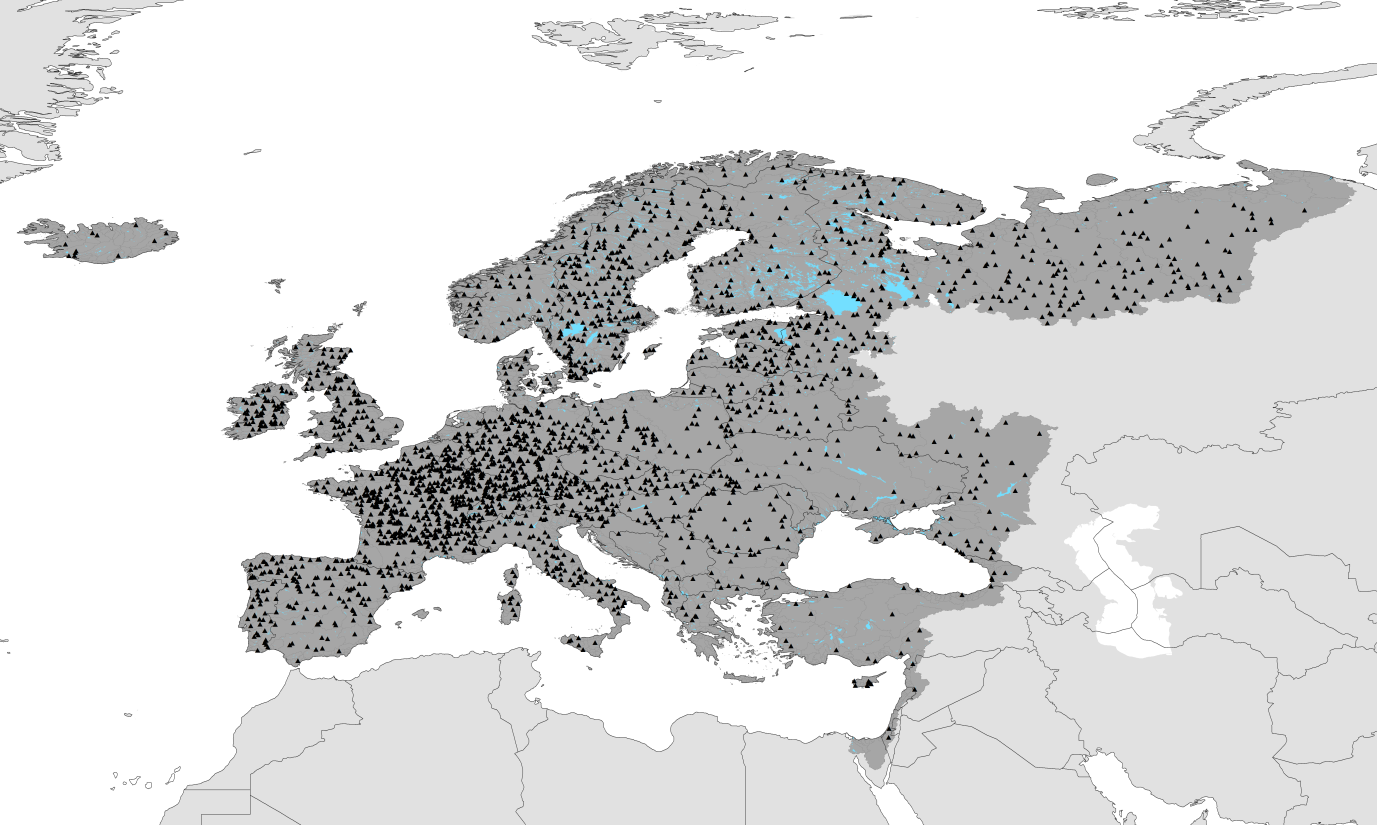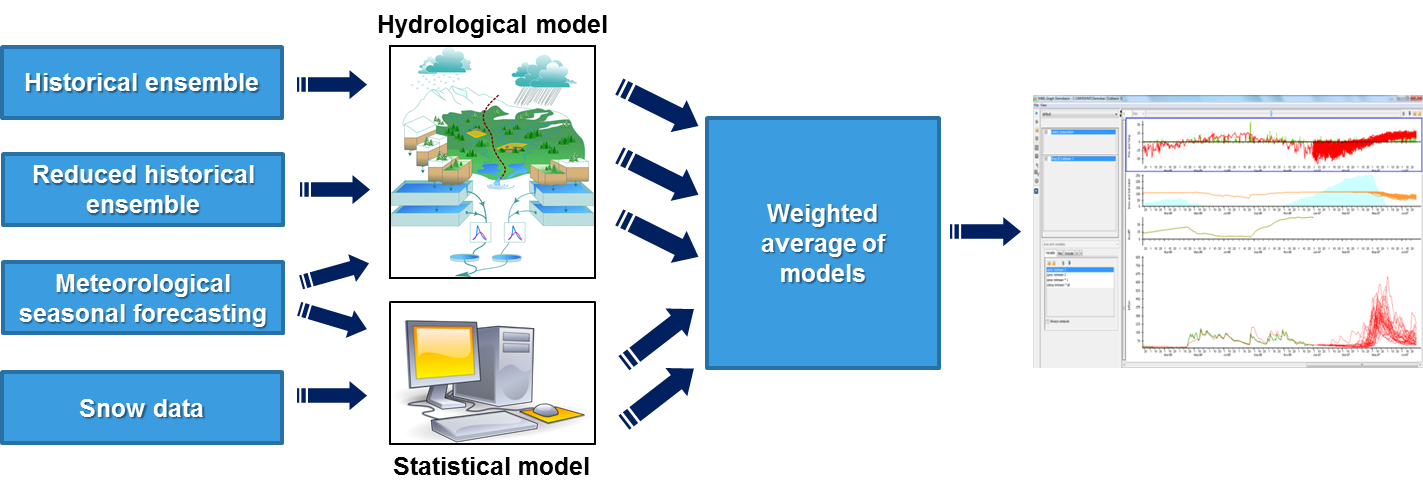SMHI’s goals for seasonal hydrological forecasting at the pan-European scale and Sweden
Contributed by Ilias Pechlivanidis
This is my first contribution as a guest author and I am very grateful to the HEPEX community for allowing me to share some of SMHI’s future goals in seasonal operational hydrological forecasting. In here I solely aim to share SMHI’s motivations and plans which will eventually assist on building a strong European community on seasonal hydrological forecasting. With one leg on researching seasonal predictive skills of hydrological models in Europe, the hydrology research unit at SMHI aims to build an operational workflow that has a beneficial impact to the stakeholders / end-users.
The background
Seasonal forecasts hold the potential for being of great value for a wide range of stakeholders / end-users who are affected by the vagaries of the climate and who would benefit from understanding and better managing climate-related risks (Wood and Lettenmaier, 2006). In Europe, there has been relatively little uptake and use of seasonal forecasts by users for decision making, compared to other parts of the world, i.e. Africa, the USA and Australia, probably due to the relatively limited skill of seasonal climate forecasts in Europe (Hansen et al., 2011; Dessai and Soares, 2013). However, recent advances in our understanding and forecasting of climate and climate change have resulted in skilful and useful meteorological predictions, which can consequently increase the confidence of hydrological prognoses, and awareness from an end-user perspective (Falloon et al., 2013).
The majority of seasonal impact modelling has commonly been conducted at only one or a limited number of basins limiting the need to understand large systems which are heavily influenced by human activities. Our goal is to complement the “deep” knowledge from basin based modelling using large scale multi-basin modelling, which are capable of representing human influences (i.e. irrigation, reservoirs and groundwater use). Such models can encompass many river basins, cross regional and international boundaries, represent a number of different physiographic and climatic zones, and describe shifts in streamflow regime due to human-impacts; hence advance process understanding by building a numerical background for comparative hydrology.
In an effort to improve climate services for end-users, the Swedish Meteorological and Hydrological Institute (SMHI) has been contributing with the pan-European E-HYPE hydrological model to analyse the seasonal predictive skill along Europe’s hydro-climatic gradient. This effort is supported by the EUPORIAS project and aims to develop an operational workflow to use E-HYPE in seasonal forecast mode. The strong engagement between the impact model providers and the end-users, which is developed within EUPORIAS, will set a new momentum in the field.
Seasonal hydrological forecasting at the pan-European scale
Forcing data – Seasonal forecasts and bias correction
Forcing data (mean daily precipitation and temperature) are derived from the WFDEI product (Weedon et al., 2014) and will drive the hydrological model as spin up for the period 1979-1995. Re-forecast forcing data (i.e. daily mean precipitation and temperature) from ECMWF’s System 4 (15 members initialised every month) are also available for the period 1996-2009.
The re-forecast data are currently bias corrected using a modified version of the Distribution Based Scaling (DBS) method (Yang et al., 2010) to account for drifting conditioning the bias correction on the lead month. DBS has originally been developed to correct biases in climate projections. It is a quantile-mapping method and has been adapted to the application to seasonal forecasts in this study. Bias-correction is conducted at all monthly initialised projections and for the period 1996-2009 using WFDEI data as reference. After bias correction, the cumulative distribution of daily precipitation and temperature values follows closely the one of the WFDEI data.
Hydrological modelling
E-HYPE refers to the setup of the HYPE model (Lindström et al., 2010) at the pan-European scale (Figure 1) , and is a dynamic, semi-distributed and process-based rainfall-runoff model capable of describing the hydrological processes at the basin scale. The model represents processes for snow accumulation and melting, evapotranspiration, soil moisture, discharge generation, groundwater recharge, and routing through rivers and lakes.
The water flow paths in soil are divided into three layers with a fluctuating groundwater table. Model parameters are linked to physiographical characteristics in the landscape, such as soil type and depths and vegetation. Elevation is used to get temperature variations within a sub-basin to influence the snow conditions. Lakes are defined as classes with specified areas and receive the local runoff and the river flow from upstream sub-basins. The outflow from a lake is determined by a rating curve. For reservoirs, a simple regulation rule can be used, in which the outflow is constant or follows a seasonal function for water levels above the threshold. A rating curve for the spillways can be used when the reservoir is full.
Irrigation is simulated based on crop water demands calculated either with the FAO-56 crop coefficient method or relative to a reference flooding level for submerged crops (e.g. rice). The demands are withdrawn from rivers, lakes, reservoirs, and/or groundwater within and/or external to the sub-basin where the demands originated. The demands are constrained by the water availability at these sources. After subtraction of conveyance losses, the withdrawn water is applied as additional infiltration to the irrigated soils from which the demands originated.
E-HYPE is setup based on global available datasets; details can be found here.
Figure 1. Domain of the E-HYPE model, and the discharge stations (triangles) used for model evaluation.
The model has been calibrated and evaluated against various multi-variables (i.e. streamflow, evapotranspiration, snow, water quality) around Europe. However, in operational mode, E-HYPE needs initial conditions (level in surface water, i.e. reservoirs, lakes and wetlands, soil moisture, snow depth) that will be obtained by driving the model using the WFDEI observations for a spin-up period. The modelling approach followed is based on an agreed protocol within EUPORIAS WP23. According to the approach, E-HYPE will perform a single continuous run for the whole period from which initial states can be taken for the seasonal re-forecasts runs, e.g. being forced by the System 4 data (see Figure 2).
Figure 2. Schematic representation of modelling approach in EUPORIAS WP23 (source: Falloon et al., 2014)
The predictive skill of river runoff for a number of European basins will be assessed on seasonal timescales. Seasonal re-forecasts will be evaluated with respect to their accuracy against observed impact variables, i.e. streamflow, at different space and time-scales; the value of the predictions will be assessed using various performance metrics. Both high flow (i.e. flood) events and low flow periods will be analysed. Verification points will be chosen to represent various climatologies, soil-types, land uses, altitudes and basin scales within Europe. In particular the model’s ability to capture flood and drought indices that are of interest to the stakeholder will be assessed.
Our efforts further aim to identify regions of similar hydrological forecasting skill and link this to physiographic-climatic characteristics and meteorological skill, in order to suggest possible model improvements. This will develop optimal geographical forecasting units, as a function of model physics and stakeholder needs.
Uncertainty and sensitivity analysis
Some basin systems exhibit distinct memory effects and may need proper initialisation of their state variables at the start of a forecast simulation. This may be expected to apply especially to systems where significant stores of soil moisture, snow and surface water in lakes/reservoirs/wetlands may reflect accumulated effects of past fluxes. In addition, the effect of initial conditions varies regionally, with lead time and with forecast starting date, and is an important aspect to consider in seasonal impact prediction systems (Li et al., 2009).
Within 2015 we will investigate the impact of model initialisation on the predictive skill of the impacts model, while sensitivity experiments will be performed to identify important state variables and their accurate identification, e.g. perturbing by ±20% the parameter values. We will perform a full analysis of forecast skill and uncertainty (characterised by the ensemble spread) as a function of the various lead times in the seasonal continuum. Such sensitivity experiments will be done on full climatological skill statistics, i.e. for the full period for which the SYSTEM 4 re-forecasts are available, but also on particular extreme events in specific regions (e.g. 2002 flood summer in central Europe).
A prototype for the hydropower industry in Sweden (leaded by Kean Foster)
The prototype is one of the six EUPORIAS prototypes exploring the value of seasonal predictions in a decision-making context for different sectors. Within our objectives, together with Lund University, is to derive a hydrologic multi-model seasonal forecast system for spring flood forecasts in the Ångerman River in northern Sweden. The forecasts are used primarily by the hydropower industry for dam regulation and production planning and may be used to optimise the balance between on one hand a sufficiently large water volume for optimal power production and on the other hand a sufficient remaining capacity to handle sudden inflows in a safe way.
The prototype is intended to offer operators information on how much water can be expected during the season and information on the timing of the onset of the floods, i.e. earlier than normal, normal, or later than normal onset. The prototype will be built using existing tools and data streams that are already in operation at SMHI, i.e. the HBV hydrological model, seasonal forecasts from ECMWF and hydrological and meteorological observations from SMHI. It is intended in the future for the prototype to be included into the current forecast system at SMHI.
The multi-model is a system of models and data selection methods developed to make seasonal hydrologic forecasts. The models are the HBV rainfall runoff model (Lindström et al., 1997) and a linear regression model that uses an SVD approach (singular variable decomposition) with the aim of downscaling atmospheric variables to accumulated seasonal discharge. The data streams are a mixture of historical observations, seasonal climate forecasts and satellite snow products, which are linked via regression analysis (Figure 3).
Figure 3. Workflow of the prototype.
To sum up
A strong community is currently been developed to assess the skills and usefulness of seasonal hydrological forecasts around Europe. SMHI has been playing a key role in disseminating medium-range hydrological forecasts in Sweden and Europe (via the European Flood Awareness System, EFAS), and aims to contribute on seasonal hydrological forecasting.
This work will be mainly conducted in 2015 but progress will be ongoing in the coming years. The hope is that this contribution will be supported by other parallel scientific efforts to understand the systems and advance operational hydrological predictions.
I would encourage readers/scientists/policy makers to keep an eye on the EUPORIAS project and emphasise on building a stakeholder dialog to drive decision making.
References can be found here.
About the author: Ilias is senior researcher at SMHI. He obtained a first class degree in Environmental Engineering and worked as a fluid mechanics researcher in Greece. He pursued his interest in hydrology at Imperial College London from where he obtained a PhD. In 2009, he moved to Wellington, New Zealand as a postdoctoral fellow at the Victoria University of Wellington, developing robust model diagnostics rooted in information theory for hydrological modelling. In 2012, Ilias joined the hydrology research group at SMHI. His current research activities focus on multi-basin modelling at the large scale, diagnostic model evaluation, impacts of climate-land use-population on hydrology and water resources, and medium-range and seasonal hydrological forecasting.



0 comments